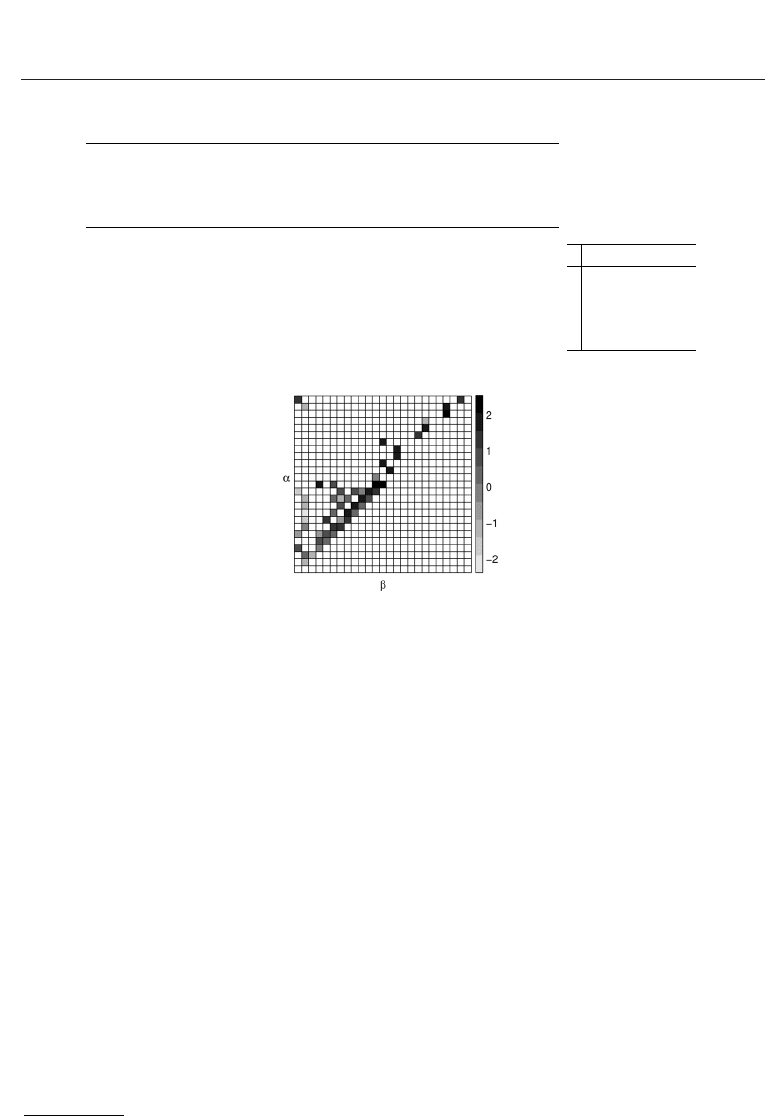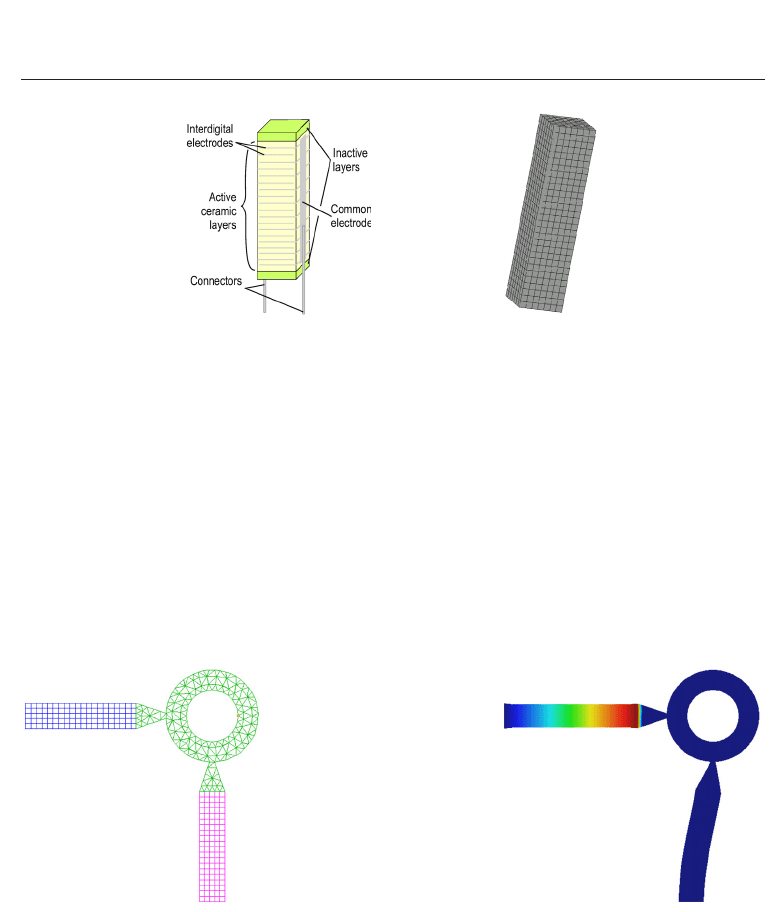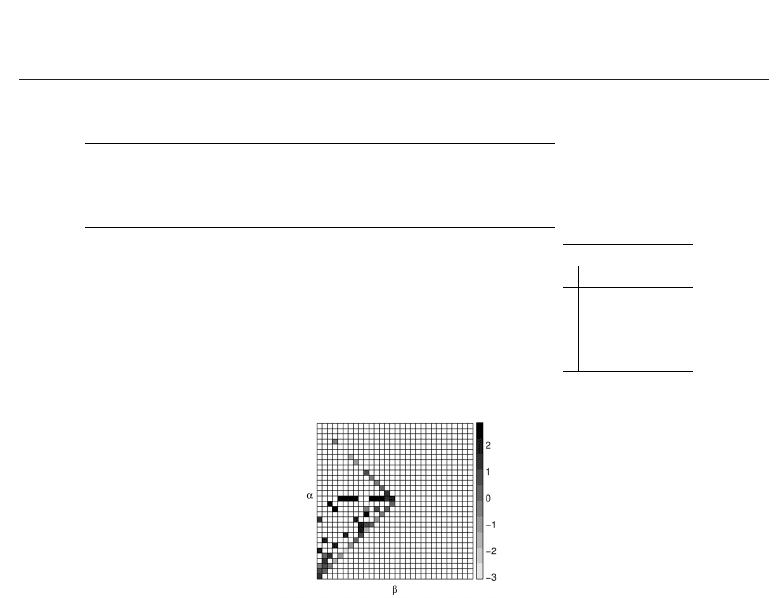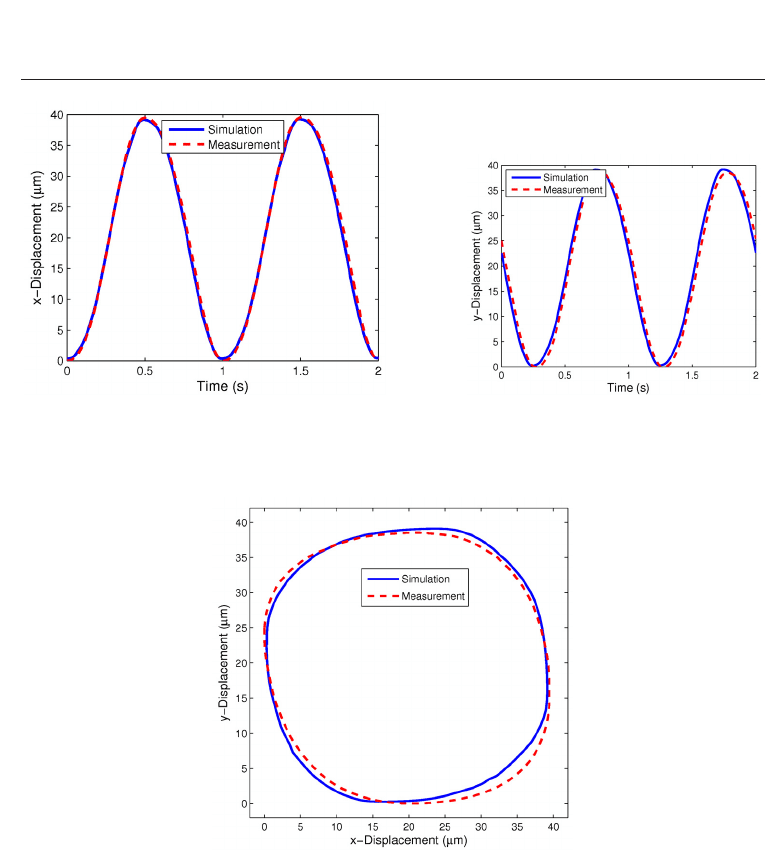Lallart M. Ferroelectrics: Characterization and Modeling
Подождите немного. Документ загружается.


Modeling and Numerical Simulation
of Ferroelectric Material Behavior Using Hysteresis Operators 19
s
11
s
33
s
12
s
13
s
66
(m
2
/N) (m
2
/N) (m
2
/N) (m
2
/N) (m
2
/N)
1, 82 ·10
−11
2, 04 ·10
−11
−4, 85 ·10
−12
−5, 71 ·10
−12
6, 33 ·10
−11
d
31
d
33
d
15
ε
11
ε
33
(C/N) (C/N) (C/N) (F/m) (F/m)
−1, 74 ·10
−10
4, 30 ·10
−10
4, 87 ·10
−10
7, 39 ·10
−9
1, 68 ·10
−8
(a)
ν β
ν
/ (m
2
·C
−1
)
ν
1 1,13 ·10
−2
2 2,33 ·10
−1
3−8,70 ·10
0
4 7,06 ·10
1
(b)
Table 1. Model parameters for the single disc actuator: (a) Material parameters and
polynomial coefficients for the irreversible mechanical strain; (b) Logarithmic values of the
Preisach weight function for M
= 25.
material parameters, the polynomial coefficients for approximating the irreversible strain and
the Preisach weight function are listed in Tab. 1.
4
A FE simulation is performed with these fitted data, using the above described boundary
conditions and a triangular excitation voltage different from the one used for the fitting
procedure. The average number of nonlinear iterations within each time step to achieve
the stopping criterion of (56) with an accuracy of δ
rel
= 10
−4
was only about two and no
restriction on the time step size had to be imposed.
Figure 13 displays in detail the comparison of the measured and FE simulated data.
This example clearly demonstrates, that using the fitted model parameters our FE scheme
reproduces quite accurately the measured data in the experiment.
7.2 Piezoelectric revolving drive
The second practical example concerns a piezoelectric revolving motor as displayed in Fig. 14
Kappel et al. (2006). This drive operates in a large frequency range, and its main advantage
is the compact construction and the high moment of torque. The rotary motion of the drive
displayed in Fig. 14 results due to a sine-excitation of the two stack actuators with a 90 degree
phase shift. The construction of the drive guarantees that shaft and clutch driving ring have a
permanently contact at each revolving position.
4
M, the discretization parameter for the Preisach plane, defines the number of discrete Preisach weights
as M
(M + 1)/2.
579
Modeling and Numerical Simulation of
Ferroelectric Material Behavior Using Hysteresis Operators

20 Will-be-set-by-IN-TECH
(a) (b)
(c) (d)
Fig. 13. Comparison of the measured and FE simulated data for the piezoelectric disc
actuator: (a) Dielectric displacement over time; (b) Mechanical strain over time; (c) Dielectric
displacement over electric field intensity; (d) Mechanical strain over electric field intensity.
Fig. 14. Princple setup of the piezoelectric revolving drive Kappel et al. (2006)
The two stack actuators are of the same type, and their principle setup is displayed in Fig.
15(a). These stacks consists of 360 layers, each having a thickness of 80 μm and cross section
of 6.8
×6.8 mm
2
. The overall length of the stack actuator is 30 mm and it exhibits a maximal
stroke of 40 μm.
For the FE simulation we choose the full 3d setup and model the whole stack as one
homogenized block. Since we currently restrict ourselves to the uni-axial electric load case, it
makes no sense to fully resolve the inter-digital structure of the electrodes. Furthermore, we
580
Ferroelectrics - Characterization and Modeling

Modeling and Numerical Simulation
of Ferroelectric Material Behavior Using Hysteresis Operators 21
(a) (b)
Fig. 15. Geometric setup and FE model of stack actuator: (a) Geometric setup of the stack
actuator; (b) Computational grid.
set the electric potential at the top surface to the measured voltage multiplied by the number
of layers, since we do not resolve the layered structure.
Again, we do an impedance measurement at the electrically preloaded stack actuator and use
our inverse scheme to get all entries of the material tensors. Next we use our measurement
setup according to Fig. 10 and excite the stack actuator with a triangular signal. The material
tensor entries as well as the polynomial coefficients for the irreversible strain and the Preisach
weight function for the hysteresis operator are provided in Tab. 2.
Now in a second step, we use the fitted material parameters for our advanced piezoelectric
material model and set up a FE model for the piezoelectric revolving drive as displayed in Fig.
16(a). For the clutch driving ring and plunger we apply standard material parameters of steel,
(a) (b)
Fig. 16. Piezoelectric revolving drive: (a) FE grid; (b) Strongly scaled (factor of about 150)
mechanical deformation for a characteristic time step, when the left actuator is at maximal
load.
and we do not model the shaft and its contact to the clutch driving ring. For the excitation we
apply DC-shifted cosine- and sine-signals. The DC-shift guarantees, that the stack actuators
are in an unipolar operating mode. The maximal achieved electric field intensity is about
2 kV/mm. In addition to the simulation, an experimental lab setup has been designed, where
581
Modeling and Numerical Simulation of
Ferroelectric Material Behavior Using Hysteresis Operators

22 Will-be-set-by-IN-TECH
s
11
s
33
s
12
s
13
s
66
(m
2
/N) (m
2
/N) (m
2
/N) (m
2
/N) (m
2
/N)
1, 29 ·10
−11
2, 54 ·10
−11
−3.72 ·10
−12
−5, 85 ·10
−12
3, 39 ·10
−11
d
31
d
33
d
15
ε
11
ε
33
(C/N) (C/N) (C/N) (F/m) (F/m)
−8, 09 ·10
−11
2, 83 ·10
−10
2, 52 ·10
−10
5, 82 ·10
−9
0, 81 ·10
−8
(a)
ν β
ν
/ (m
2
·C
−1
)
ν
1 1,79 ·10
−2
2 6,60 ·10
−2
3 8,13 ·10
−1
4−1,91 ·10
1
(b)
Table 2. Model parameters for the stack actuator: (a) Material parameters and polynomial
coefficients for the irreversible mechanical strain; (b) Logarithmic values of the Preisach
weight function for M
= 30.
the shaft has also been neglected, Hegewald (2008). The displacements in x- and y-direction
have been measured with a laser vibrometer.
In Fig. 16(b) we show the mechanical deformation of the whole considered setup for a
characteristic time step, when the left stack actuator is at maximal stroke. A comparison
between measured and simulated displacements both in x- and y-direction is displayed in
Fig. 17. The fit for the displacement in x-direction is almost perfect; in y-direction there is
some small difference.
Furthermore, in Fig. 18 we show the trajectory of one point on the ring. One observes that
the resulting trajectory differs from a perfect circle. We also performed a simulation with a
linear piezoelectric material model and obtained a perfect circle for the trajectory. Hence, the
deviation from a perfect circle is clearly a result of the nonlinear (hysteretic) behavior of the
stack actuators.
8. Summary and outlook
We have discussed a nonlinear piezoelectric model based on Preisach hysteresis operators
and explained in detail the efficient solution of the governing partial differential equations by
a quasi Newton scheme within the FE method. Moreover, we have described a procedure
for determining the model parameters from measurements. Practical applications have
582
Ferroelectrics - Characterization and Modeling

Modeling and Numerical Simulation
of Ferroelectric Material Behavior Using Hysteresis Operators 23
(a) (b)
Fig. 17. Comparison between measurement and simulation: (a) displacement in x-direction;
(b) displacement in y-direction.
Fig. 18. Trajectory of one point of the ring obtained from measurements and simulation.
demonstrated, that the model is very well capable to provide qualitatively and quantitatively
correct simulations.
Currently, we are investigating the extension of our model to also take ferroelastic loading into
account. Such an approach can, e.g., be found in Ball et al. (2007). A very interesting option for
modelling both ferroelectricity and ferroelasticity in a thermodynamically consistent manner
is enabled by so-called hysteresis potentials, see Krejˇcí (2010).
Referring to Equation (28), Equation (29), we finally describe a possible extension to a
multi-axial piezoelectric model. First of all, we have to apply a vector Preisach hysteresis
model (see, e.g Mayergoyz (1991)), which for each electric field intensity vector E provides a
583
Modeling and Numerical Simulation of
Ferroelectric Material Behavior Using Hysteresis Operators

24 Will-be-set-by-IN-TECH
vector for the irreversible polarization P
i
P
i
= H(E) . (66)
Furthermore, we compute the coupling tensor
[e(P
i
)] as in Equation (15) and rotate it in the
direction of the irreversible polarization P
i
. Similarly as in the scalar case, we define the
irreversible strains by
[S
i
]=
3
2
β
1
·|H[E]| + β
2
·|H[E]|
2
+ ···+ β
n
·|H[E]|
n
e
P
e
P
T
−
1
3
[I]
(67)
with the unit vector of the irreversible polarization defined by e
P
= P
i
/|P
i
|.
9. References
Adams, R. A. (1975). Sobolev Spaces, Pure and Applied Mathematics, Academic Press.
Ball, B. L., Smith, R. C., Kim, S. J. & Seelecke, S. (2007). A stress-dependent hysteresis model for
ferroelectric materials, Journal of Intelligent Material Systems and Structures 18: 69–88.
Bassiouny, E. & Ghaleb, A. F. (1989). Thermodynamical formulation for coupled
electromechanical hysteresis effects: Combined electromechanical loading,
International Journal of Engineering Science 27(8): 989–1000.
Belov, A. Y. & Kreher, W. S. (2006). Simulation of microstructure evolution in polycrystalline
ferroelectrics ferroelastics, Acta Materialia 54: 3463 3469.
Brokate, M. & Sprekels, J. (1996). Hysteresis and Phase Transitions, Springer, New York.
Cimaa, L., Laboure, E. & Muralt, P. (2002). Characterization and model of ferroelectrics based
on experimental preisach density, Review of Scientific Instruments 73(10).
Delibas, B., Arockiarajan, A. & Seemann, W. (2005). A nonlinear model of piezoelectric
polycrystalline ceramics under quasi-static electromechanical loading, Journal of
Materials Science: Materials in Electronics 16: 507–515.
Everett, D. (1955). A general approach to hysteresis, Trans. Faraday Soc. 51: 1551–1557.
Fröhlich, A. (2001). Mikromechanisches Modell zur Ermittlung effektiver Materialeigenschaften
von piezoelektrischen Polykristallen, Dissertation, Universität Karlsruhe (TH),
Forschungszentrum Karlsruhe.
Hegewald, T. (2008). Modellierung des nichtlinearen Verhaltens piezokeramischer Aktoren,
PhD thesis, Universität Erlangen-Nürnberg, URL: http://www.opus.ub.
uni-erlangen.de/ opus/volltexte/2008/875/, URN: urn:nbn:de:bvb:29-opus-8758.
Hegewald, T., Kaltenbacher, B., Kaltenbacher, M. & Lerch, R. (2008). Efficient modeling of
ferroelectric behavior for the analysis of piezoceramic actuators, Journal of Intelligent
Material Systems and Structures 19(10): 1117–1129.
Huber, J. E. (2006). Micromechanical modelling of ferroelectrics, Current Opinion in Solid State
and Materials Science 9: 100–106.
Huber, J. E. & Fleck, N. A. (2001). Multi-axial electrical switching of a ferroelectric: theory
versus experiment, Journal of the Mechanics and Physics of Solids 49: 785 811.
Hughes, D. C. & Wen, J. T. (1995). Preisach modeling and compensation for smart material
hysteresis, Proceedings: Active Materials and Smart Structures, Vol. 2427, pp. 50–64.
Hughes, T. J. R. (1987). The Finite Element Method, 1 edn, Prentice-Hall, New Jersey.
Kaltenbacher, B. & Kaltenbacher, M. (2006). Modelling and iterative identification of
hysteresis via Preisach operators in PDEs, in J. Kraus & U. Langer (eds), Lectures on
584
Ferroelectrics - Characterization and Modeling

Modeling and Numerical Simulation
of Ferroelectric Material Behavior Using Hysteresis Operators 25
Advanced Computational Methods in Mechanics, de Gruyter, chapter 1, pp. 1–45. ISBN
978-3-11-019556-9.
Kaltenbacher, B., Lahmer, T., Mohr, M. & Kaltenbacher, M. (2006). PDE based determination
of piezoelectric material tensors, European Journal of Applied Mathematics 17: 383–416.
Kaltenbacher, M. (2007). Numerical Simulation of Mechatronic Sensors and Actuators, 2. edn,
Springer, Berlin. ISBN: 978-3-540-71359-3.
Kaltenbacher, M., Kaltenbacher, B., Hegewald, T. & Lerch, R. (2010). Finite element
formulation for ferroelectric hysteresis of piezoelectric materials, Journal of Intelligent
Material Systems and Structures 21: 773–785.
Kamlah, M. (2001). Feroelectric and ferroelastic piezoceramics - modeling of
electromechanical hysteresis phenomena, Continuum Mech. Thermodyn. 13: 219–268.
Kamlah, M. & Böhle, U. (2001). Finite element analysis of piezoceramic components
taking into account ferroelectric hysteresis behavior, International Journal of Solids and
Structures 38: 605–633.
Kappel, A., Gottlieb, B., Schwebel, T., Wallenhauer, C. & Liess, H. (2006). Pad - piezoelectric
actuator drive, Proceedings of the 10th International Conference on New Actuators,
ACTUATOR 2006, Bremen, Germany, pp. 457–460.
Krasnoselskii, M. & Pokrovskii, A. (1989). Systems with Hysteresis, Springer, Heidelberg.
Krejˇcí, P. (1996). Hysteresis, Convexity, and Dissipation in Hyperbolic Equations, Gakkotosho,
Tokyo.
Krejˇcí, P. (2010). An energetic model for magnetostrictive butterfly hysteresis, 5th International
Workshop on MULTI-RATE PROCESSES & HYSTERESIS in Mathematics, Physics,
Engineering and Information Sciences. Pécs, Hungary.
Kuhnen, K. (2001). Inverse Steuerung piezoelektrischer Aktoren mit Hysterese-, Kriech- und
Superpositionsoperatoren, Dissertation, Universität des Saarlandes, Saarbrücken.
Lahmer, T., Kaltenbacher, M., Kaltenbacher, B. & Lerch, R. (2008). FEM-Based Determination
of Real and Complex Elastic, Dielectric and Piezoelectric Moduli in Piezoceramic
Materials, IEEE Transactions on Ultrasonics, Ferroelectrics, and Frequency Control
55(2): 465–475.
Landis, C. M. (2004). Non-linear constitutive modeling of ferroelectrics, Current Opinion in
Solid State and Materials Science 8: 59–69.
Linnemann, K., Klinkel, S. & Wagner, W. (2009). A constitutive model for magnetostrictive
and piezoelectric materials, International Journal of Solids and Structures 46: 1149 1166.
Mayergoyz, I. D. (1991). Mathematical Models of Hysteresis, Springer-Verlag New York.
McMeeking, R. M., Landis, C. M. & Jimeneza, M. A. (2007). A principle of virtual work for
combined electrostatic and mechanical loading of materials, International Journal of
Non-Linear Mechanics 42(6): 831–838.
Pasco, Y. & Berry, A. (2004). A hybrid analytical/numerical model of piezoelectric stack
actuators using a macroscopic nonlinear theory of ferroelectricity and a preisach
model of hysteresis, Journal of Intelligent Material Systems and Structures 15: 375–386.
Rupitsch, S. J. & Lerch., R. (2009). Inverse method to estimate material parameters for
piezoceramic disc actuators, Applied Physics A 97(4): :735–740.
Schröder, J. & Keip, M.-A. (2010). Multiscale modeling of electro–mechanically
coupled materials: homogenization procedure and computation of overall moduli,
Proceedings of the IUTAM conference on multiscale modeling of fatigue, damage and fracture
in smart materials, Springer, Heidelberg.
585
Modeling and Numerical Simulation of
Ferroelectric Material Behavior Using Hysteresis Operators

26 Will-be-set-by-IN-TECH
Schröder, J. & Romanowski, H. (2005). A thermodynamically consistent mesoscopic model for
transversely isotropic ferroelectric ceramics in a coordinate-invariant setting, Archive
of Applied Mechanics 74: 863–877.
Smith, R. C., Seelecke, S., Ounaies, Z. & Smith, J. (2003). A free energy model for hysteresis in
ferroelectric materials, Journal of Intelligent Material Systems and Structures 14: 719–737.
Su, Y. & Landis, C. M. (2007). Continuum thermodynamics of ferroelectric domain evolution:
Theory, fnite element implementation and application to domain wall pinning,
Journal of the Mechanics and Physics of Solids 55: 280 305.
Visintin, A. (1994). Differential Models of Hysteresis, Springer, Berlin.
Wang, J., Kamlah, M. & Zhang, T.-Y. (2010). Phase field simulations of low dimensional
ferroelectrics, Acta Mechanica . (to appear).
Xu, B.-X., Schrade, D., Müller, R., Gross, D., Granzow, T. & Rödel, J. (2010). Phase field
simulation and experimental investigation of the electro-mechanical behavior of
ferroelectrics, Z. Angew. Math. Mech. 90: 623–632.
Zäh, D., Kiefer, B., Rosato, D. & Miehe, C. (2010). A variational homogenization approach to
electro-mechanical hystereses, talk at the 3rd GAMM Seminar on Multiscale Material
Modeling, Bochum.
586
Ferroelectrics - Characterization and Modeling
